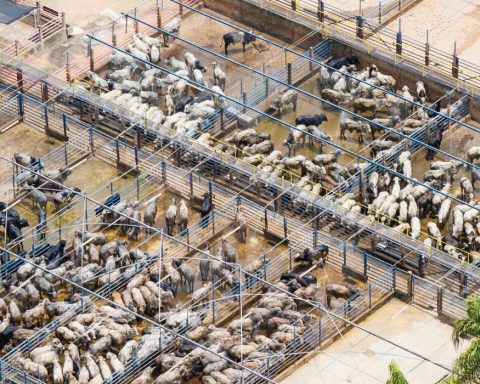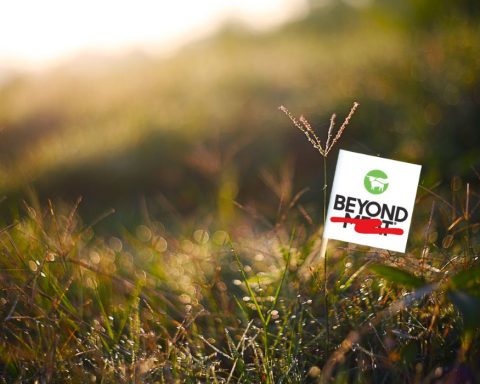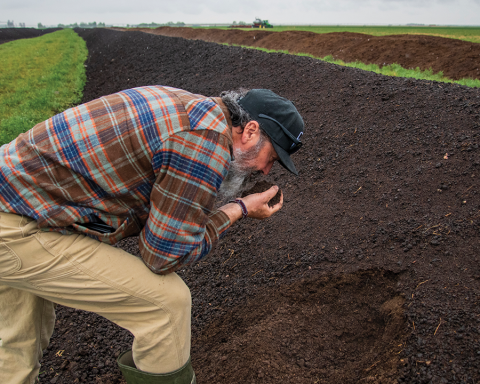Stephen Tyson and Yves St. Amand spent years managing bars and restaurants in Toronto before deciding to blend their professional experience in beer and hospitality with their passion for sustainability.
They are now building what they say will be Canada’s first carbon-negative brewery in Peterborough, Ontario. Just as concerns over the climate crisis were mounting, the popularity of craft beer exploded. Craft beer now makes up around a quarter of the American beer market, and a growing number of brewers have started focusing on shrinking their environmental footprints. The process of brewing beer is notorious for being energy- and water-intensive, but sustainability hasn’t always been a priority for many brewers in their first years of operations.
That’s a trend Karbon Brewing is hoping to reverse by designing a brewery with sustainability in mind at every step.
“I really like the challenge of flipping the focus from ‘How do we become this big brand by selling the most beer possible, and then worrying about sustainability?’ to ‘Let’s put sustainability first’ and ‘How do we do a brewery right?’” says Bernardo Zamora, Karbon’s brewmaster.
A big question will be how to scale Karbon’s production while maintaining its green brewing chops. Zamora may be comforted to know that sustainability experts say large, well-established beer companies tend to lead the pack when it comes to sustainability within the industry. As more consumers look to local micro-breweries, they may be surprised to learn that it isn’t always the most sustainable route.
“The larger brewers, from an environmental sustainability perspective, in general, outperform craft brewers. They’re producing fewer product types and have very efficient systems,” says Barry Ness, an associate professor at the Lund University Centre for Sustainability Studies in Sweden.
In a 2018 paper, Ness analyzed 70 craft breweries and found that those that opened decades ago tended to prioritize sustainability more than others. “It showed that maybe you need to get to a certain stage of growth … before you can start working on sustainability initiatives,” he says.
The larger brewers, from an environmental sustainability perspective, in general, outperform craft brewers. They’re producing fewer product types and have very efficient systems.
–Barry Ness, associate professor at the Lund University Centre for Sustainability Studies in Sweden
In Canada, Ronald Morrison, a sustainability consultant who offers his services to craft breweries, says many smaller breweries aren’t tracking metrics like their water-to-beer ratio. This is an important first step in figuring out where there’s room for improvement. “You can’t manage what you can’t measure,” he says, adding that American craft breweries tend to be a bit more advanced on sustainability than Canadian ones. According to a trade association called Beer Canada, the Canadian breweries that have been tracking those metrics have cut greenhouse gas (GHG) emissions by 57.3% and energy use by 48.1% since 1990.
In stark contrast to some of North America’s largest food companies, the three largest beer companies by sales in the United States – AB InBev (which owns Budweiser), Molson Coors and Constellation Brands (which owns Corona) – all at least partially track and disclose emissions that come from their supply chains (in addition to those of their operations and energy use). According to AB InBev’s 2021 ESG report, the company reduced its overall emissions from a 2017 baseline by almost 14% and has pledged to be net-zero by 2040. Molson Coors plans to reduce emissions from its direct operations and its supply chain by 50% and 20%, respectively, by 2025 (from a 2016 baseline).
Pints that prioritize planet
There are many ways breweries can alter their operations to make them more sustainable, from installing solar panels on their roofs (such as at Roadhouse Brewing in Wyoming) to sending their spent grain to bakers to make bread, like they do at Henderson Brewing in Toronto. And the 9,000 breweries in the United States are at varying stages of implementing these practices.
Researchers estimate that the production of alcoholic beverages, including beer, represents 0.7% of global GHG emissions. Packaging often makes up a large chunk of a brewery’s emissions (roughly 40% for big beer companies), but some brewers are working to tackle that by ditching plastic for biodegradable six-pack holders.
Some breweries have adopted carbon capture technology that sucks up the CO2 that’s a by-product of brewing and allows them to use it for other purposes. Molson Coors has installed a system at its facility in B.C.’s Fraser Valley that collects the CO2 and then liquefies it, before using it in other parts of the brewing process. “We’re less dependent on getting CO2 tankers coming in,” says David Hamel, general manager of operations for Western Canada at Molson Coors. “Very few breweries actually go through the process of installing that type of technology.”
Chuck Skypeck, director of technical brewing projects at the U.S. Brewers Association, estimates that only 40 to 50 smaller breweries in the United States are using carbon capture systems. He says filtering and compressing that CO2 for storage can take a lot of energy. So when it’s used on a smaller scale, it just doesn’t make sense from a sustainability perspective.
Roadhouse Brewing is one craft brewery that has installed a carbon capture system. Heralded as one of the most sustainable craft breweries in the United States, it has cut down its CO2 consumption by 70% since it opened in 2012, says co-founder Colby Cox. It has also reduced its ratio of the number of gallons of water needed to produce a gallon of beer to 4-to-1 (industry average is around 7-to-1), thanks to a system that recaptures the water vapour lost in the brewing process.
Is bigger always better?
Using local ingredients can also lower a brewery’s environmental footprint, cutting down on shipping and transportation emissions. Matron Fine Beer, in Bloomfield, Ontario, tries to use as many local ingredients in its beer as possible to support local farmers and the environment. The brewery even marks the percentage of local ingredients that goes into each beer on the bottom of every can (Matron’s Dapper Vienna lager, for instance, contains 95% Ontario-grown ingredients). Farm breweries (such as Meuse Brewing in Ontario and Bale Breaker in Washington State) take things one step further by growing their own ingredients onsite.
But two of the main ingredients in beer – barley and hops – need specific climate conditions to thrive. So there are limitations as to where these ingredients can be grown, says Skypeck. He adds that the small scale of farm breweries coupled with the fact that barley and hops need to be processed before being used in brewing offset any GHG advantage of their use of local ingredients.
We’re looking at the entire process with a holistic view as opposed to just slapping solar panels on the brewery.
–Karbon Brewing CEO Stephen Tyson
When it comes to distribution, craft operations often have a sustainability edge over corporate ones, as most of them produce only enough beer to sell onsite. In Canada, 94% of breweries are small, local operations that produce less than 15,000 hectolitres of beer.
Half Hours on Earth has been delivering its beer locally in Huron County, Ontario, with the help of an electric vehicle. The small two-person operation, which brews fruity sours and funky farmhouse ales, opened its doors in 2016 and became Canada’s first certified carbon-neutral brewery.
Cox, of Roadhouse Brewing, notes that large beer corporations have centralized supply chain management with two or three facilities where they ship all their ingredients and brew all of their products, before distributing them across the country, increasing their footprint. “They may have more sophisticated systems. They might even spend more money on sustainability initiatives, but they have a huge logistics problem,” he says.
For Skypeck, contrasting the sustainability of corporate beer against craft brews is like comparing apples and oranges. “On one hand, you have multibillion-dollar international companies, brewing tens of millions of barrels of beer annually, that have resources to invest in new technologies. On the other hand, you have small craft breweries that might employ one person and brew only hundreds of [beers] a year.”
Tapping conscious consumers
The costs of retrofitting a brewery can often be a barrier for smaller brewers looking to become more sustainable, says Morrison. But greening processes can have huge benefits for the bottom line in terms of energy and water savings. They might also help brewers secure higher price points. A 2018 study from the University of Indiana found that a majority of American beer drinkers are willing to pay more for beer that’s environmentally friendly.
That market is one that Karbon Brewing is hoping to tap into. The company’s new facility is being constructed on the campus of Trent University. A research partnership with the university will help them develop green brewing technologies.
The Karbon team has a rare opportunity to build a green brewery from scratch. “We’re looking at the entire process with a holistic view as opposed to just slapping solar panels on the brewery,” says CEO Stephen Tyson.
For too long, brewing has been a wasteful and unsustainable industry. That’s beginning to change. Hopefully what’s happening at Karbon (and other sustainable breweries) can serve as a model for future brewers to prioritize the planet from the first pint.
Alex Robinson is the associate editor of Corporate Knights and an Ottawa-based journalist.







